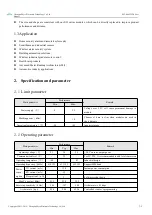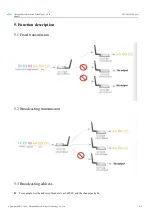
Chengdu Ebyte Electronic Technology Co.,Ltd.
E22-400T22DC User
Manual
Copyright ©2012–2019
,
Chengdu Ebyte Electronic Technology Co.,Ltd.
8-18
8. Repeater networking mode
No.
Description
1
After setting the repeater mode by configuration, switch to the normal mode and the repeater starts working.
2
In the repeater mode, ADDH, ADDL are no longer used as the module address, but is correspondingly paired with the NETID. If the data of
one of the networks is received, it is forwarded to another network. The network ID of the repeater itself is invalid.
3
In repeater mode, the repeater module cannot transmit and receive data, and cannot perform low-power operation.
4
The user enters the other mode from mode 3 (sleep mode) or during the reset process, the module resets the user parameters during which
the AUX outputs low level.
Repeater networking rules:
1. Forwarding rules, the repeater can forward data in both directions between two NETIDs.
2. In repeater mode, ADDH\ADDL is no longer used as the module address, and it is used as a NETID forwarding
pairing flag.
Figure:
①
Primary repeater
“Node 1” NETID is 08.
“Node 2” NETID is 33.
Primary repeater 1‘s ’ADDH\ADDL are 08
,
33.
So the signal sent by node 1 (08) can be forwarded to node 2 (33)
At the same time, node 1 and node 2 have the same address, so the data transmitted by node 1 can be received by node 2.
②
Secondary repeater
Secondary repeater’s ADDH\ADDL are 33
,
05.
Therefore, Repeater 2 can forward the data of Repeater 1 to the network NETID: 05.
Thus node 3 and node 4 can receive node 1 data. Node 4 outputs data normally, and node 3 has a different address than node 1, so no
data is output.
③
Two-way repeater
As shown in the figure: the data sent by node 1, the nodes 2, 4 can receive the data sent by node 2, 4, and node 1 can also
receive it.






































